Sled dogs: what you need to know about them, and how they were brought

The breed has brown eyes or blue eyes. And this one has both options at once.
One of the coolest Tutu Adventure stories is how polar explorers Dmitry and Matvey Shparo drive schoolchildren’s expeditions to the North Pole. Yes, right to the very pole - skiing. In the children's camp "Big Adventure" in Karelia, where you can go just like that, and young polar explorers come to prepare for the expedition, 60 sled dogs live. With these dogs you can just live 14 days and go a long tracking route.
A year and a half ago, some of the dogs were transferred to Moscow. In the north of the Sokolniki park there is a fenced off area of the husky park, and there you can snuggle with Siberian husky and Chukchi sledding. Just go to the base, pay 400 rubles for a ticket and be among the shaggy dogs. These are the very dogs that participate in the adventure, just every Muscovite can reach them.
And the beauty is that they are safe for humans. The basic breed from which they were bred is just a pack of dogs that lived near the camps of nomadic peoples. The Yaranks of the Chukchi stood, and around the dogs ran free-range. And if at least one of them (any) growls at the child, then she is immediately shot as dangerous.
Many generations of culling dogs that are aggressive towards people, and selecting the most obedient (for riding in teams) have given a dog that starts to fawn on every person he sees. But in this case, this does not mean that they do not compete with each other.
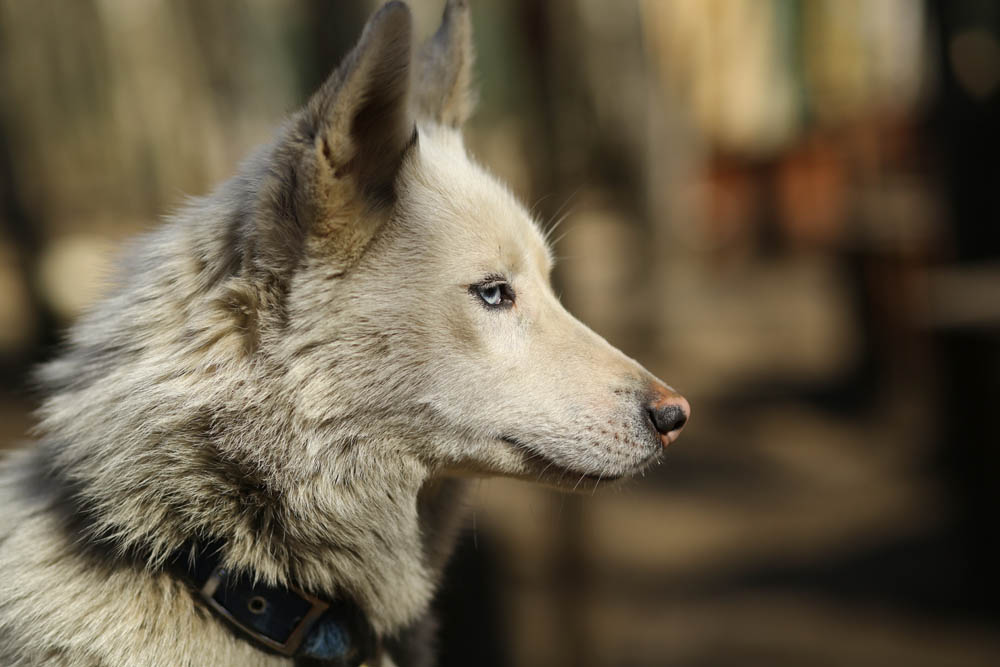
Who are sled dogs?
These are animals that have been specially bred in order to transport goods and people. Husky is a breeding breed (specially created), but the basic (aboriginal) ancestors are not very different in character and appearance. Husky, Chukchi sledding, Malamutes and other sledding breeds are different options for adapting a dog for transporting sledges. For example, malamutes are needed in order to carry large heavy loads over short distances. They become attached to the owner and are quite aggressive. Husky is smaller, but more hardy: the selection went so that they could drag the sleds for a very long time.
As I have already said, the source breed has become very friendly to people because of the selection conditions. The second property - there is no attachment to a specific owner, because they did not live in man-dog pairs, but simply near camps. Well, different people can harness the team, so there was no reason to form such ties. That is, virtually any new person after a minimum time, they begin to perceive, like an ordinary dog - the owner. The third property is that they are very good hunters, but they hunt for themselves, they bring nothing to people. Because in the summer they look for food for themselves, and in the winter they are fed with stocked frozen fish. In the nursery, of course, they get food all year from people.
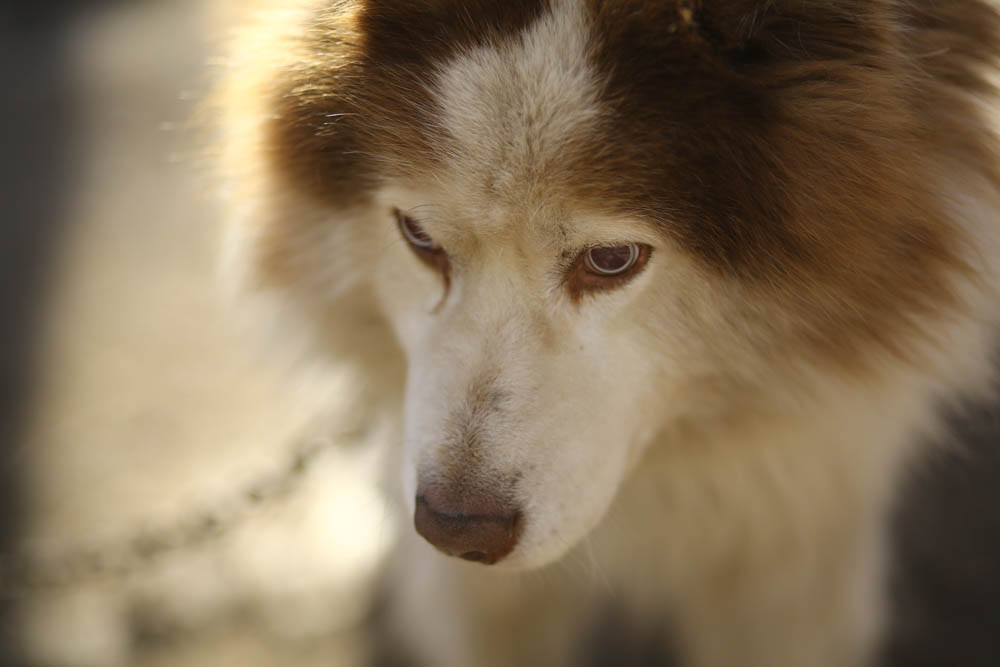
What are they doing at the kids camp?
In April 2006, Matvey Shparo went to the North Pole with Prince Alberta of Monaco. Then they took the dog teams. The prince after the expedition presented the first dogs to Matvey, they were left in a camp in Karelia. Then it turned out that they really like to communicate with children and are very useful in children's programs and children's trips. They began to breed, purchase, and in 10 years there were about 60 of them.
A year and a half ago, in the Sokolniki park, they wanted to open a platform with dogs and offered to bring some of the dogs to Moscow. They fenced off about a hectare in the forest, made a base, brought 16 dogs. There are 22 dogs at the base in Sokolniki (six puppies were already born here). For the winter, two more teams are being transferred from Karelia to Sokolniki - 12 dogs, because in Moscow there are a lot of skating rides, social programs are being carried out for children with disabilities, and there are obviously more volunteers than the capabilities of Moscow dogs. At the base there are both husky and Chukchi sledding.
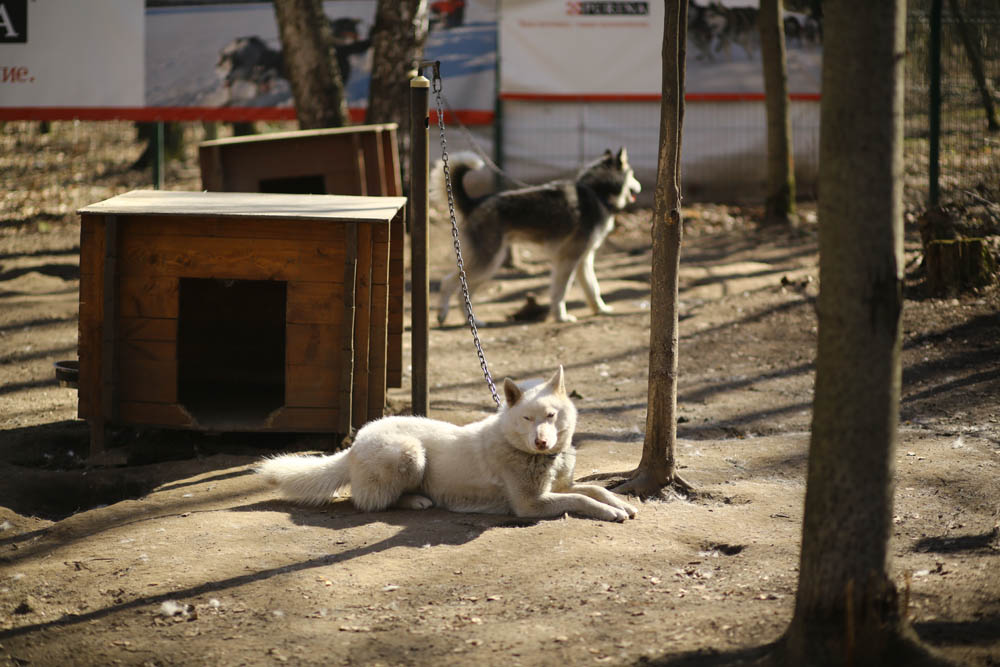
Husky.
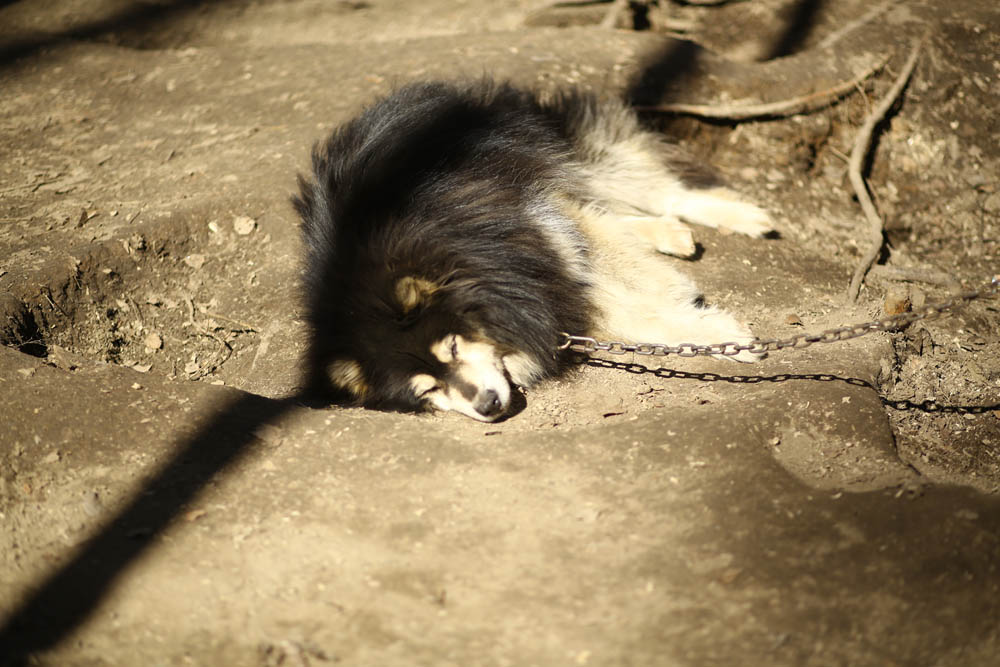
Chukchi driving.
Since 2008, dogs in the camp "Big Adventure" in Karelia began to be used for children's trips, including in the summer. In general, there are four ways to go somewhere with a sled dog:
- Just walk - like with any other breed;
- Harness from 2 to 12 dogs in sledges (usually 6 teams in long sledges: the front teams are smart and know the team well, the root sledges are the strongest and move the sled when stuck, and in the middle the pair are not the most experienced);
- Dress the dog in harness (so that the pressure is not transferred to the collar, but distributed throughout the body closer to the center of gravity) and attach the leash to the skier’s belt. Then the dog will pull the skier. And the skier can yell at her the usual teams for the team, voice turning her right to left and accelerating, slowing down. Such a team is from one dog.
- And to do the same in the summer, just not to ski, but to run. Children from about 6 years old are already confidently running with dogs after minimal training: for example, the standard summer program is 2-3 kilometers around the base in Sokolniki with stops. The main thing is not to forget the commands, otherwise it turns out that it is not the child who controls the dog, but the dog - the child.
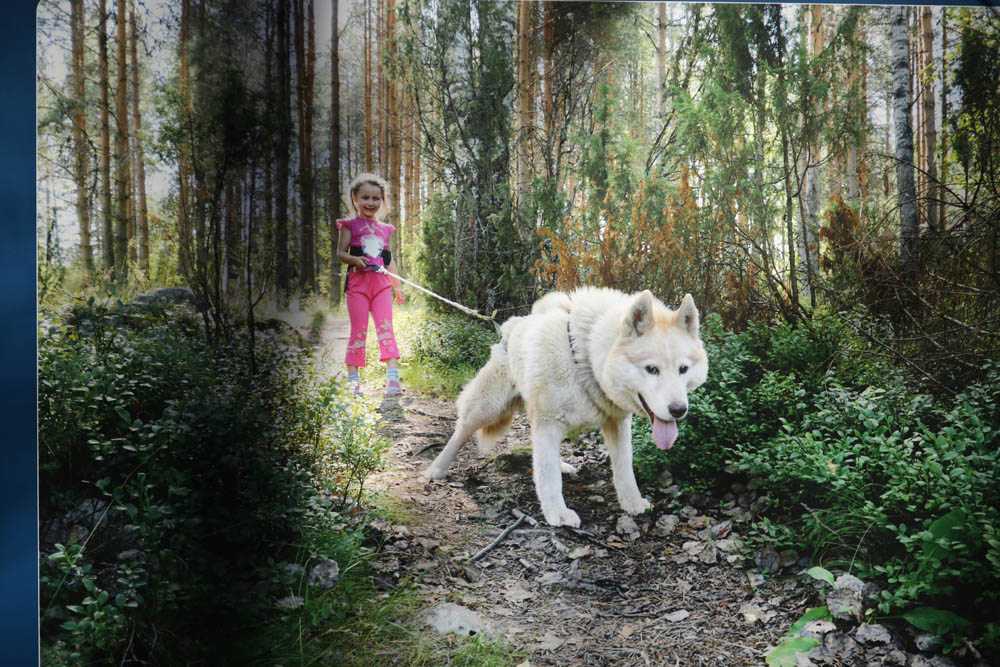
Photo booth: this is last summer.
Here, on our Tutu Adventures, you can watch a 14-day program of the route with dogs.
The next important aspect of working with dogs is that they help children socialize a lot. They give a lot of kinesthetic development (for young children it is very important to feel something, but here you can squeeze, stroke, and even the dog will try to play too). The only thing is that at this age, children are often addicted and try to tear off the ear of the dog, or simply “flirt” the animal to the stage of “leave me alone,” so you must do this in the presence of an adult. Over 12 years in the Karelian camp more than ten thousand children went through classes with dogs, and they never bit or scratch anyone. Due to the features of the selection of a husky, even when she is very unpleasant, she tries to get out and go to the booth. You can’t climb into the booth after her - this is very strict. There she takes refuge from all the hardships of life.
Naturally, dogs are larger than children, and they can drop a child out of joy or put their paws on his shoulders, which can also frighten him. Therefore, all classes for the smallest - in the presence of a parent and employee base.
Another aspect of working with dogs is treatment (canistherapy). There are many different options for using dogs for treatment or rehabilitation. A significant case was last year at the base in Sokolniki: a boy with an autism spectrum disorder suddenly became very carried away by one of the dogs. Prior to that, he had not spoken to anyone: neither his parents, nor other children, nor psychologists. He was sent to the dogs. At first he just played, and then suddenly he started trying to talk to the dog he liked.
But do not think that you can become attached to a healing dog, and all ailments will pass. Canister therapy is a versatile technique and a long process, one dog doctor helps restore motor function, the other they replace the therapist. In Finland, for example, dog practice has firmly entered the practice of speech therapists. You can lie in a bunch of dogs and treat chronic stress, canistherapy can help with autistic disorders and slow development, dogs can help with problems with motor functions. Publications - here. In Russian there is a book “Medical cynology. Theoretical approaches and practical implementation. ” "Medical" dogs have special training - they, like therapists, are certified. First - selection, then - training. The work rate of a dog in France is two sessions a day for 1 hour each, then the dogs get tired. Why are you tired? Because, for example, it is necessary that the child scratched her for 15 minutes in a row. The dog in this lesson should stand silently and not hide. Certified dogs are very patient. In France, there is a lesson when a patient reads a book to a dog, and she listens very carefully and constantly looks at it, does not correct it. Helps gain confidence.
What you need to know about the team?
Sled dogs live in packs and have a clear hierarchy. The native breed simply independently divided into small groups at the camp, and when it was necessary to assemble a team, they simply took part of the group: they got along well in advance. But with breeding husky every year you need to re-assemble the team of teams.

They are very fond of running with sledges, and at first even "non-matching" dogs are passionate about excitement and joyfully pull. But when they get a little tired, the odds begin. Then problems arise with the execution of commands: two dogs made a command, and two more did not, because they are too dominant to do like these two. In the worst case, a fight can begin. As a result, the musher (the person managing the team) must know each dog and put together only those that are combined. At the beginning of each year, base carriages at first test two dogs, then couples gather in groups of four, and then they collect teams of six dogs. For four teams to work in the park you need 24 dogs, plus several spare ones. This process goes on anew every year, because in a year the places in the hierarchy change: dogs are quite aggressive among themselves and can sort things out.
They fight often (if allowed). In the husky park, they sit separately (do not reach each other), and walk freely in groups of several dogs so that there are no obvious opponents inside the group. During walks, the level of internal aggression decreases as they scatter across the territory and begin to seek entertainment. They react very nervously to horses in Sokolniki: some are hiding, some are trying to hunt them. More foxes come to the base and very rarely moose. They are also sensitive to them and scare them away.
Can I go in today and touch the dogs?
Yes. The main service of the husky park - you can just come and spend an hour with the dogs. A ticket costs 400 rubles on a weekend and 300 rubles on a weekday. It is better to call in advance: on weekends there is a busy schedule, and on weekdays you can come almost any time. At lunch, there are almost no visitors from 12:00 to 16:00 on weekdays, so all dogs will play with you at once. 15-20 minutes - for the educational part and safety measures, the rest of the time - just you and the dogs. The base is open from 10:00 to 18:00 every day, except Mondays.
The second way to have fun is sledding. This is mainly in winter, because snow is needed (in summer, sledges can be replaced with a special trolley on wheels). It is possible with musher or independently (after preparation). On their own - either briefly in a team of two dogs, or after the courses: children who practice sledding train at the base. This is a long training program. Children of the School of Musical Schools not only ride with dogs, but also look after them - they even give them a special massage.
Well, you can run a dog or go skiing with it in the winter. In the summer, dog runs are very popular. If you agree in advance, then you can order an animation program for a group of 10 children — this is approximately an hour-long quest for Sokolniki with orientation and dashes from dogs to dogs. Often birthdays are celebrated this way, because then 15–20 minutes - for cake and tea in the Arctic module.
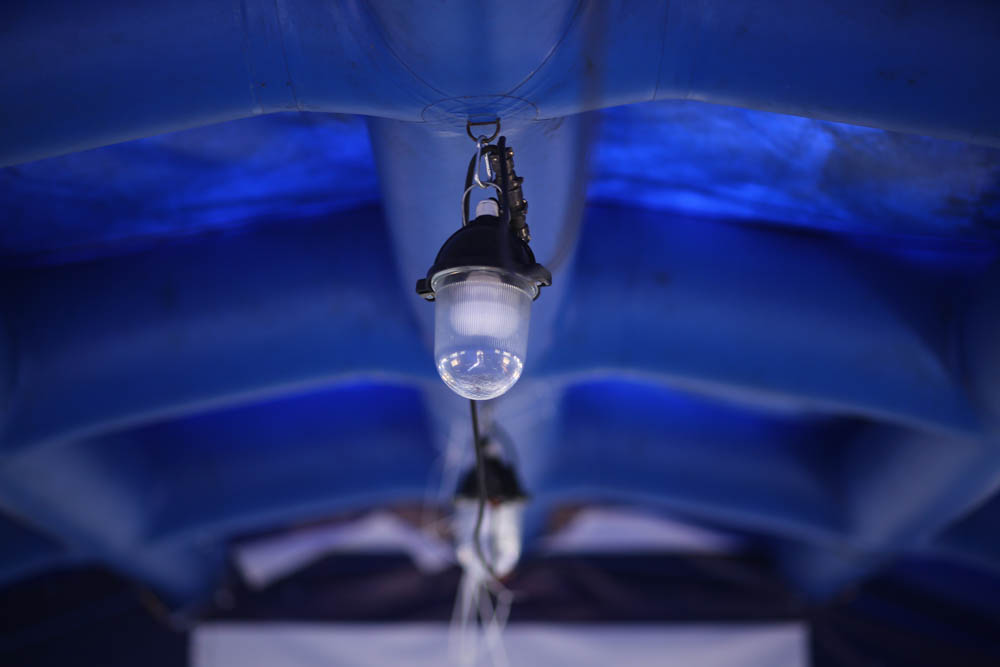
Specifically, this module has never been to the North Pole, but was used in the training of polar children in Karelia. A small museum of polar equipment is arranged here.
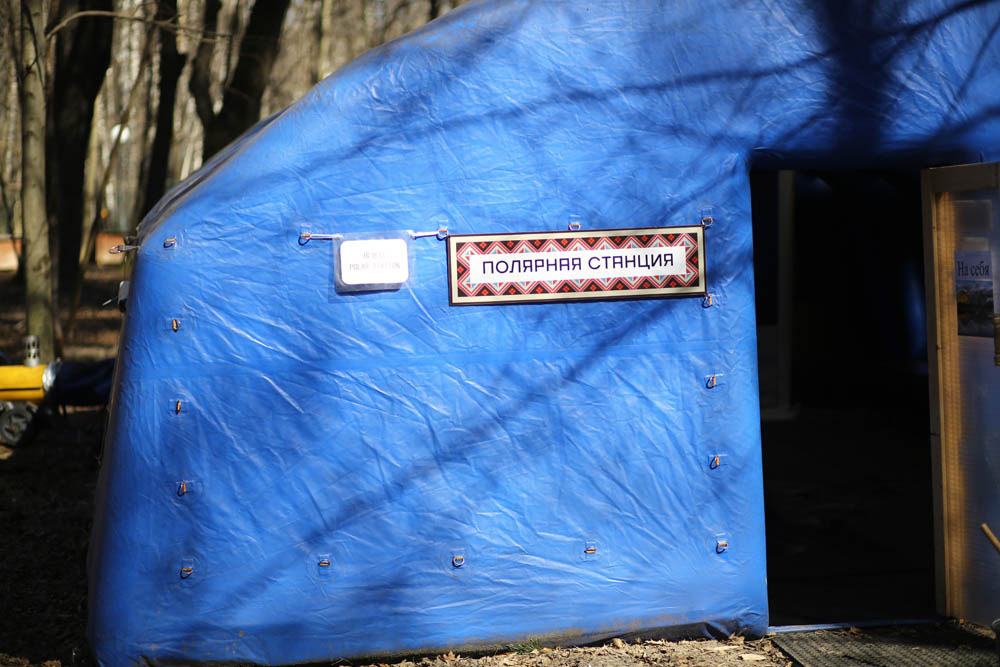
Team-building exercises are done in the same children's groups, which is also important for some classes.
Foreign tourists are often brought to the base (in winter) - just a ride in a harness. But dog handlers say: they often do this on the first or second day of arrival in Russia, so Thais, Vietnamese and Chinese just jump out of the bus into the snowdrifts and start taking pictures. Dogs are noticed after 20 minutes. A

place for safety instruction: “Do not tear off the dog’s ears!”
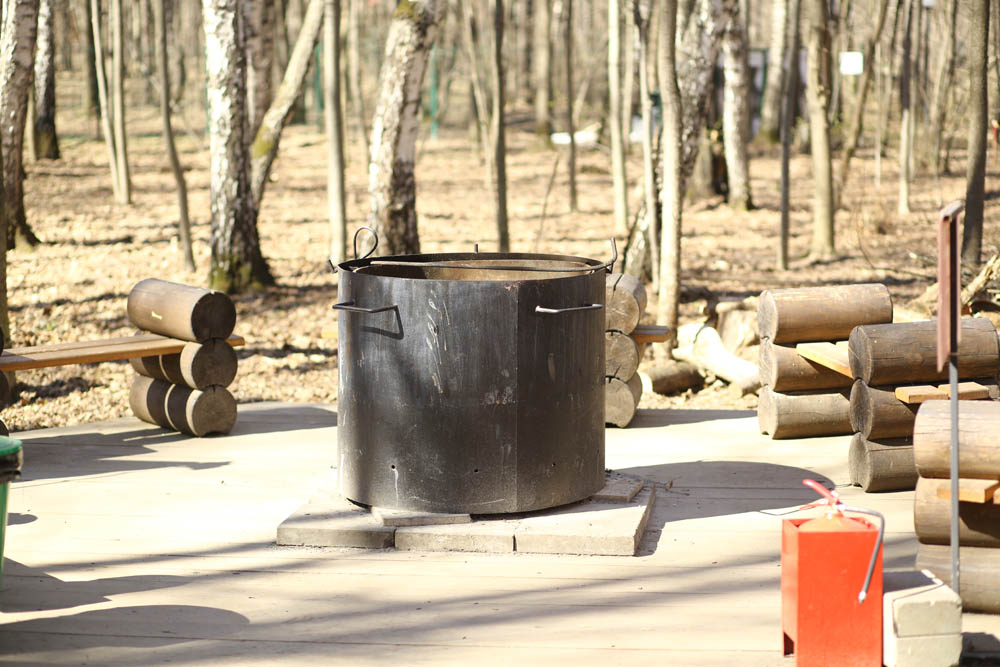
For gatherings by the fire.
Base life
There are dog handlers at the base, Natalya and Natalya. One of them is also a certified canis therapist, and the second is a veterinarian.
The morning begins with feeding, and different dogs receive different food and different vitamins. Because there are one-year-old puppies and old dogs at the base. After 10 years, they begin honorable old age, and you need to monitor the joints, so you need a special feed. Then they need to be drunk. Then clean in the aviary. Then the dogs run. In April, they actively molt, comb them out so that when their guests arrive, their fur does not climb. Then you just need to watch, periodically add water. Classes begin: dog handlers work individually with each dog. The main teams for the team are here below:
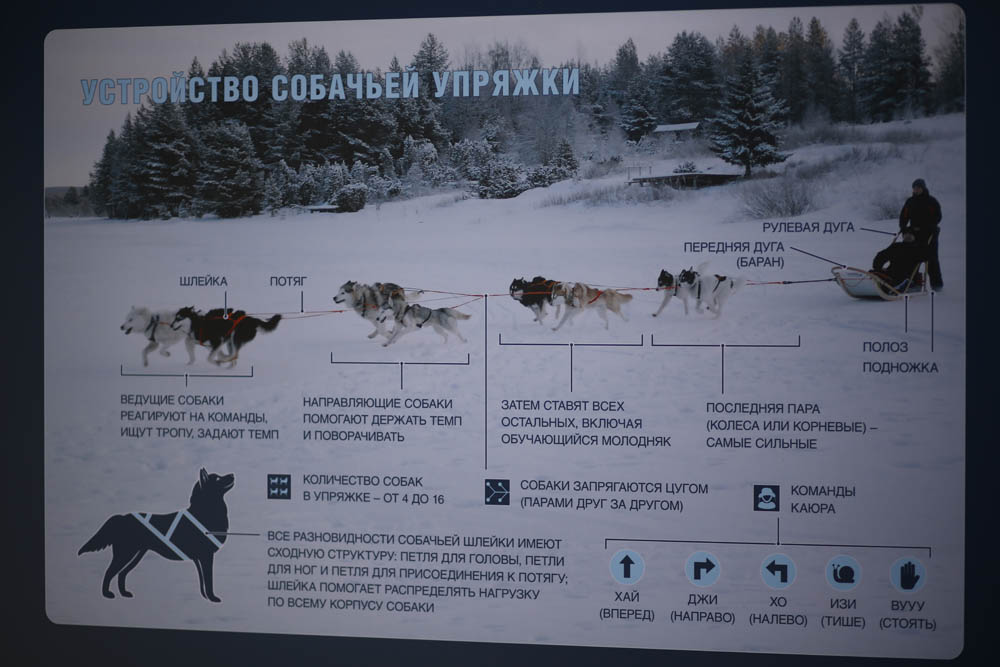
This is the most important thing for the dog. Serve the paw and other non-functional teams they are not taught. The maximum set, in addition to these teams of harnessing or running, is also “wait”, “sit”, “do not eat”, “eat”.
Here is an example of a task:
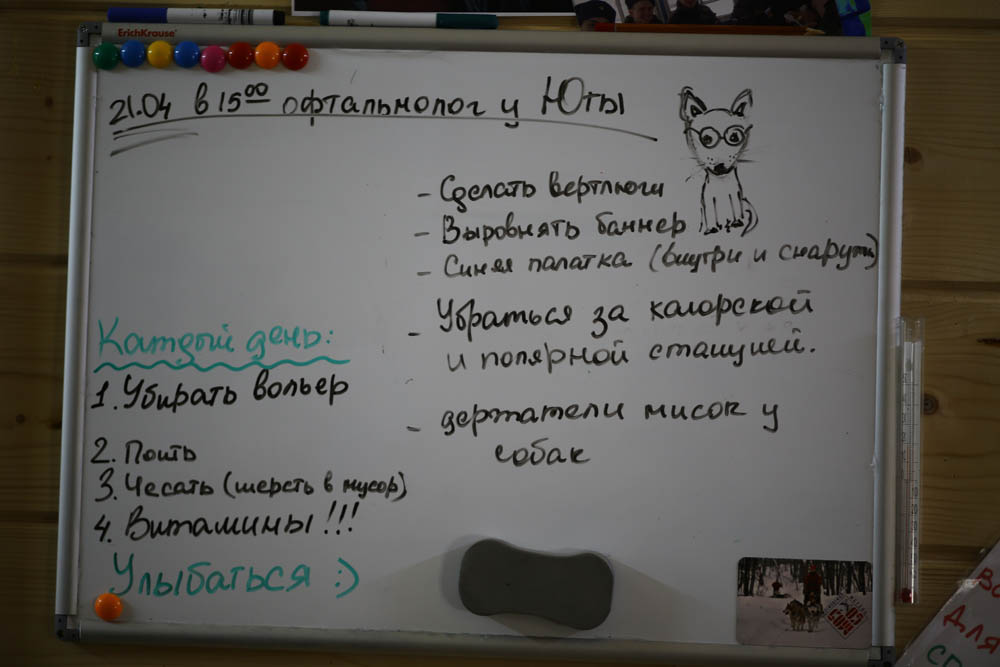

Next - periodic processing, visits to the veterinary clinic. There are cycles of mandatory prevention from helminths, other parasites, annual vaccinations including rabies, regular cleaning of the ears and clipping of the claws.
At the base there is a very old dog with a sick spine, it lives separately, because it is contraindicated even for a long time to cuddle with people. In winter, she had a heater, she slept beside him.
Puppies born at the base were trained separately. First, quarantine: from infancy, it is impossible for people, because little puppies really have no immunity. Then, as they grow older and vaccinate, they gradually get acquainted with dog handlers, then the circle of communication gradually expands. Employees were brought from the office so that the dogs knew that people were different. Then the puppies began to be brought out, shown to children, stroked. Step by step, the puppies learned that people are different, they smell differently, they move differently, and in general. This is important because every human race smells very different, and tourists from all over the world come to visit the base. Puppies at first are surprised (they can get scared), then they get used to it. The main thing was to have time to teach this before the World Cup, because there were so many new people.
Training is also separate. Usually young dogs are trained separately from experienced ones: the first classes are held together when the young one watches what needs to be done. They perfectly follow after other dogs.
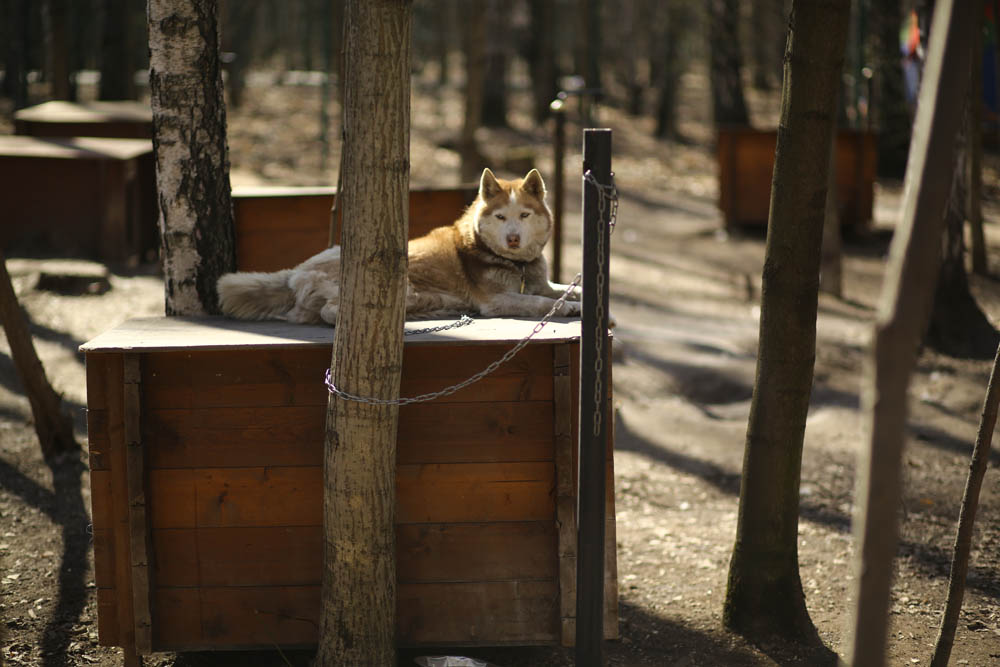
How to prepare for a trip to the dogs?
Dressing so as not to be afraid to get dirty. Dogs jump, lick, rub their hair. It is very important not to take fur things: they hunt for everything fluffy and very excited when they see the fur. In winter, children came with pompons on hats, dogs tried to eat them - they also caught on some instinct.
The first time they usually play with everyone, the second or third time they come to certain dogs.
Huskies themselves are very energetic and love people. When you arrive at the enclosures with the same guard dogs, dog handlers often hold balls that your dogs play during training, so they begin to carefully monitor the toys. And it seems to people that they are paying attention to them. Husky doesn’t need anything like this: they immediately run up to play with you. True, not all: someone is not in a good mood, someone likes silence, someone is tired after training, but 18–19 out of 22 dogs are usually ready to communicate.
Another interesting case: parents brought a boy of about 5 years old, who was afraid of dogs. We started with the calmest. They taught you how to iron, so as not to pull the wool. How to approach, reach out your hand and not move, to sniff and meet. It was said that the child began to concentrate more, to interact better with parents. There was an adult who overcame children's fear of dogs, but it took more time.
It is best for them to scratch the croup (back of the back), neck, face closer to the forehead. Some of the friendliest ones belly up: this is a sign of trust, you have to be very careful. There are dogs who are constantly trying to substitute the croup, so when you try to take pictures you get without a “face”. But there are those who understand the game with the camera and look at the lens.
That, in fact, is all that I wanted to tell about sled dogs. With us were the head of the base Vladimir Rodionov:
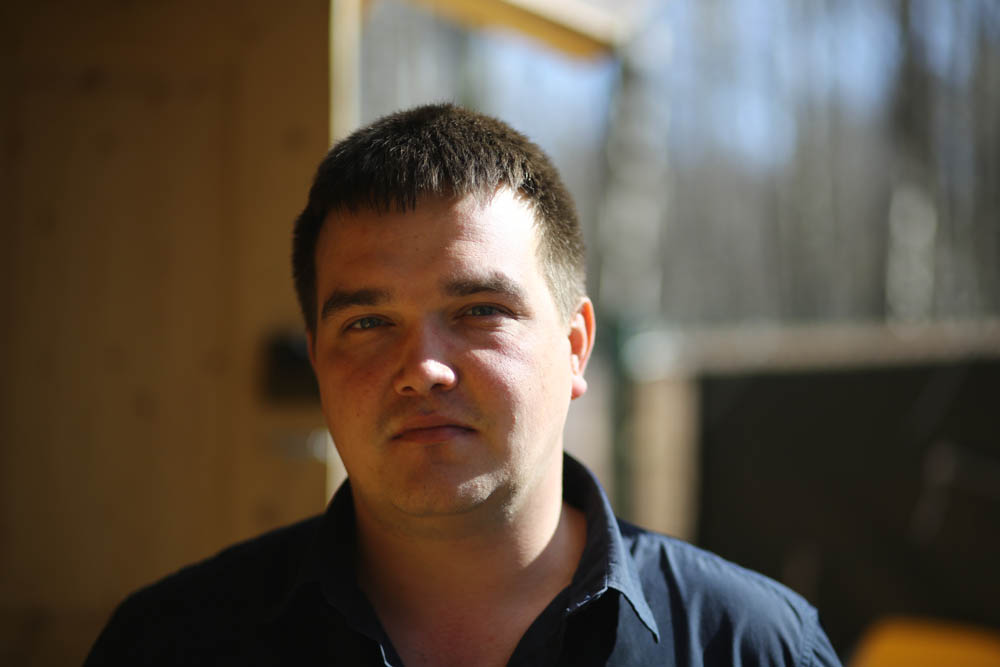
Cynologist, Canis therapist and instructor of youth tourism Natalya Akimova:

And the cynologist and veterinarian Natalya Kosenko:
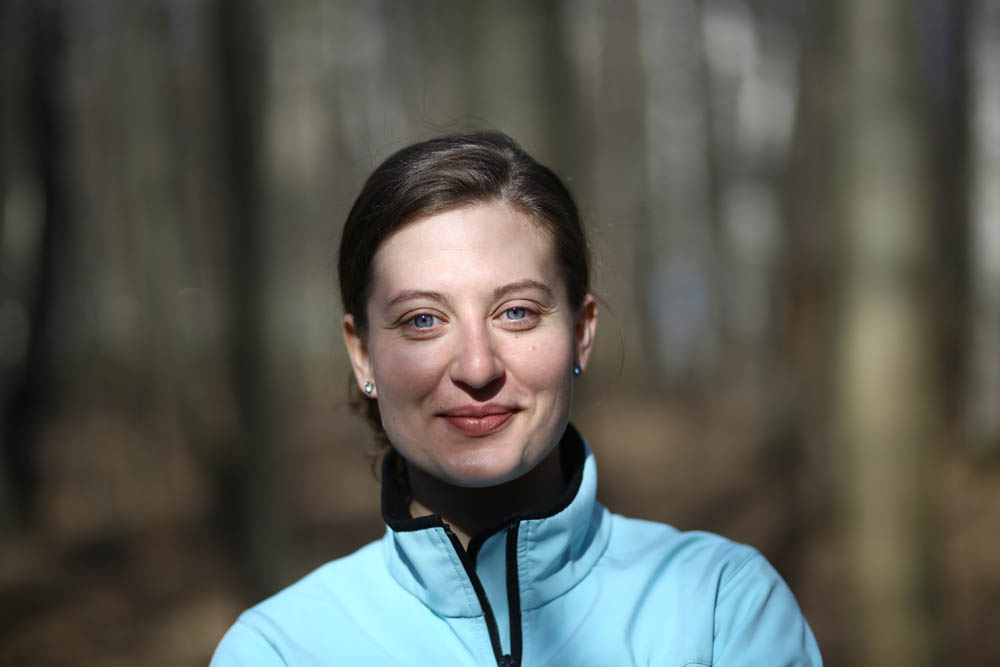
And, of course, the dogs of the base:
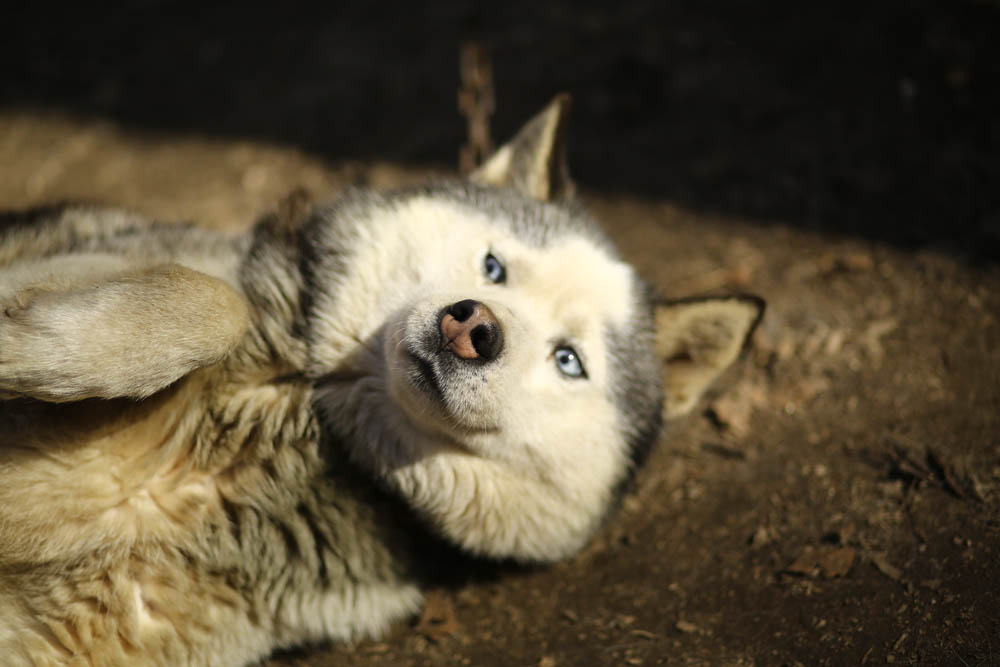
The site of the base is here , Address: 5th Radiation Prose, ow . 16-A, telephone 8 (901) 725-93-56.
Great adventures (many days) in Shparo camps and with dogs here : you can choose a wellness program for the child for the summer. Look at the links, there are very detailed programs and a lot of training. Well, here are the photos:
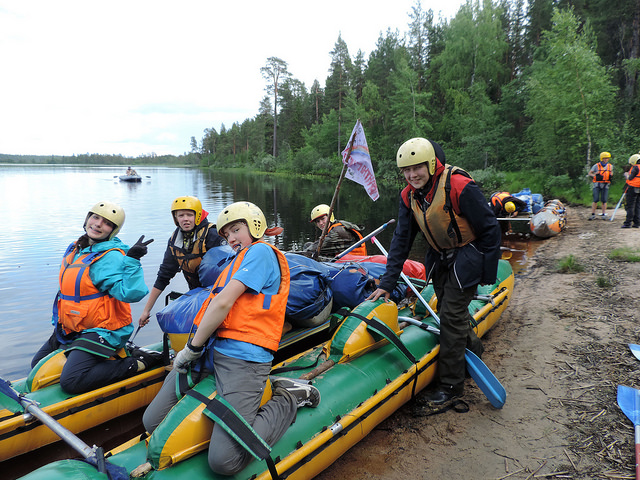
Photos from this adventure.
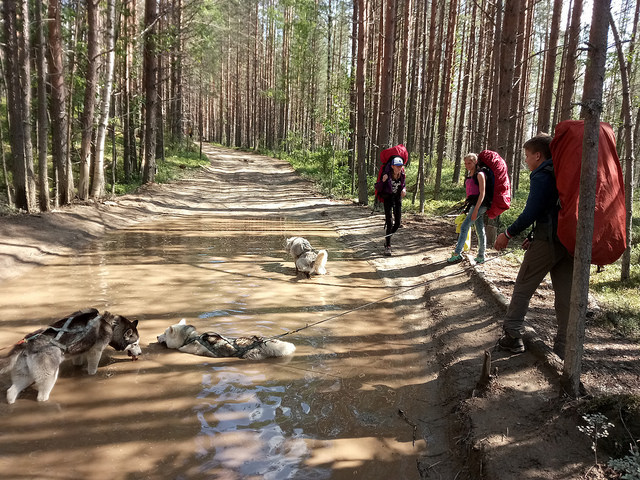
This is with husky tracking .
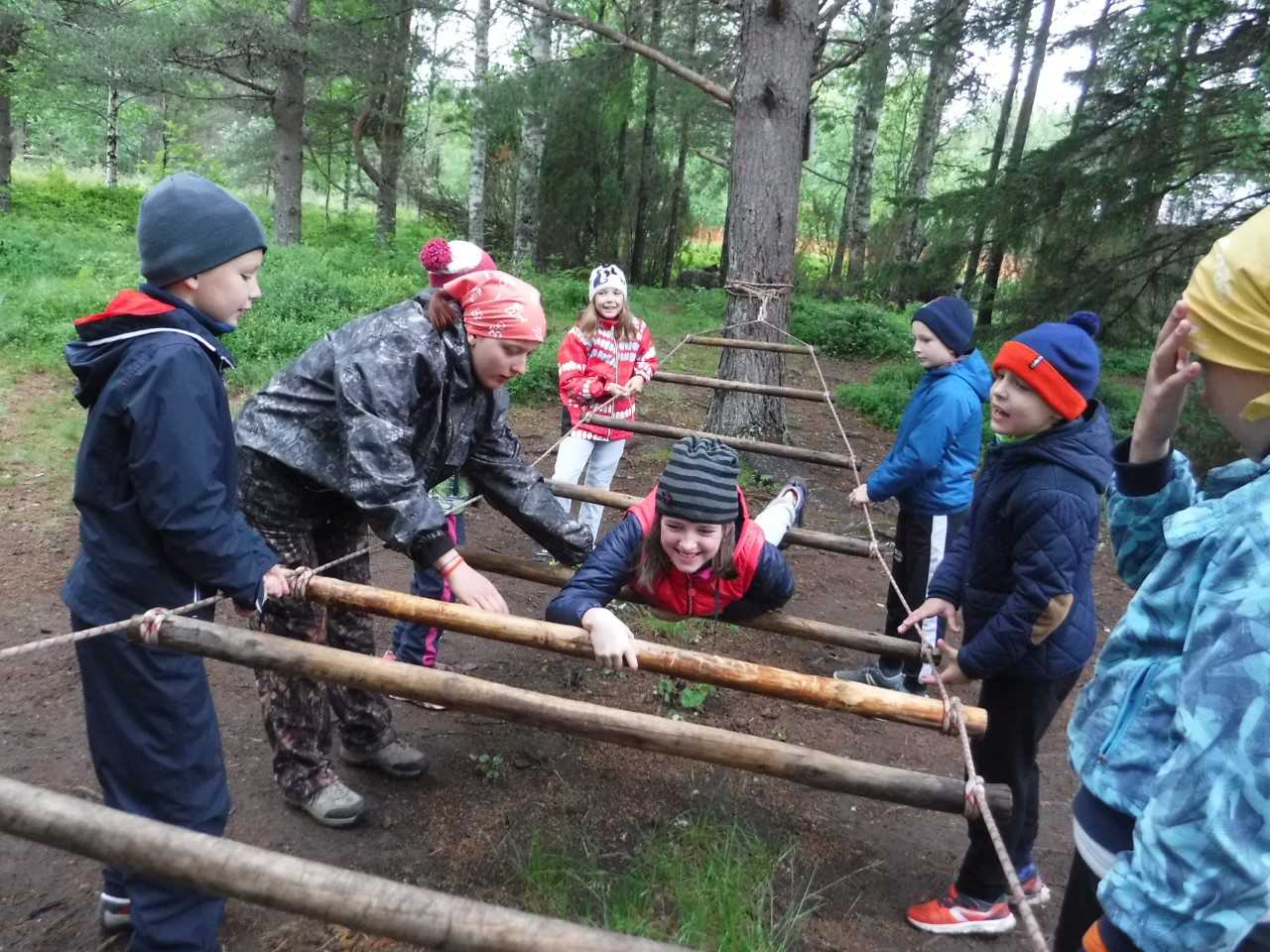
And this is from the camp with a bunch of radial trips .
Our other Tutu posts Adventures: unusual tourism , about yachts , about vaccinations , about going on tours , about medical insurance when traveling .
